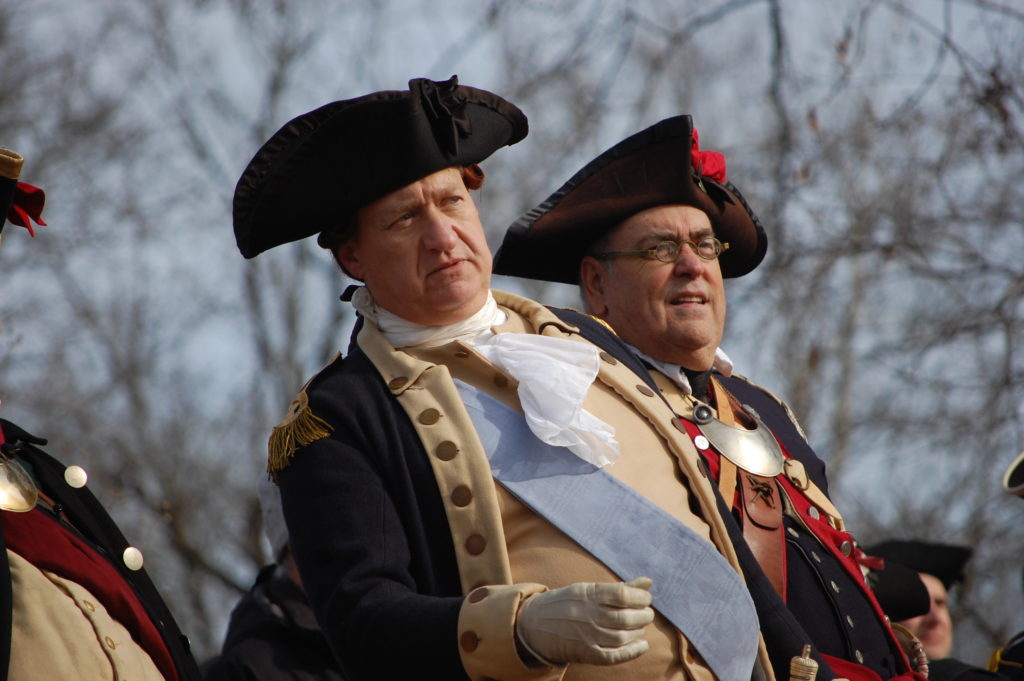
Written by Thomas Maddock, a historical interpreter at Washington Crossing Historic Park.
Leadership is a complex topic because there are so many variables to becoming a leader. My definition of a leader is: “a person who others choose to follow.”
Why we choose to follow involves many issues. Paramount among these qualities are: ambition, vision, courage, conviction, belief in one’s self, perseverance, honesty, dedication, and a deep belief in the cause.
George Washington’s many accomplishments were very important to the birth of our nation, but the interesting part is the obstacles he had to overcome. He was born into an upper-middle-class Virginia family, but did not have the advantage of an English education. He was locally schooled but largely self-educated.
Washington developed a strong desire to excel so he could fit into the landed gentry in northern Virginia. Determined to make a name for himself, he inherited some family land and married Martha Custis, a wealthy widow, but he had higher goals.
He enlisted with the Virginia militia because he believed military experience would help his image and participated in the French and Indian War. Washington wanted desperately to become an officer in the British army but was turned down; however, he gained valuable experience. Afterwards, he became deeply involved in running the family estate, Mt. Vernon, and served in the House of Burgesses.
Washington was initially loyal to the Crown but, disillusioned with British taxes and regulation, he became vocal in resisting British mandates and was appointed a delegate to the Continental Congress. He attended in full military uniform in May 1775 and was appointed commander of the newly formed army outside Boston.
Washington’s first task was to organize the men into an army. He had precious little experience, but his drive and ambition were critical to the task, driven by a strong commitment and belief in the cause. Relying on input from his officers, he forged an effective fighting force and learned from his mistakes to grow as a competent commander. A consultative leader, he received ideas from his subordinates that could become successful battle plans.
Against the most powerful military of his time, Washington demonstrated incredible courage that eventually led his army to defeat the British and their Hessian allies. The carefully crafted attack that involved the famous crossing of the Delaware in December 1776—beginning the army’s turnaround—led to Washington’s first victory, achieved through the courage and determination of the troops and their leader.
Getting soldiers to march nine miles downriver in a blizzard, with rags wrapped around their feet, or with bare feet, was a feat (no pun intended) for the ages. These soldiers stuck with Washington because they knew he believed in them and their cause and took a huge personal risk leading them into battle.
Washington not only had to contend with the enemy but also Congress—constantly pleading for money, men, weapons, food, supplies, and gunpowder—and was often left on his own to solve his perplexing problems. This took precious time from his mission to keep the army together and defeat the British, but he never gave up.
Washington was the right man at the right time.
______________________________________________________________
Thomas Maddock is a historical interpreter at Washington Crossing Historic Park (WCHP) who has been giving guided tours for more than a decade in the park where he lived as a youth. A history major at Haverford College, he served in the U.S. Marine Corps and has extensive management experience in the corporate world. Tom received the Volunteer-of-the-Year award from the Friends of Washington Crossing Park in 2010 and subsequently joined the WCHP staff. He is a longtime student of organizational leadership and has spoken about Washington’s leadership style and decision-making to various groups on behalf of WCHP.

